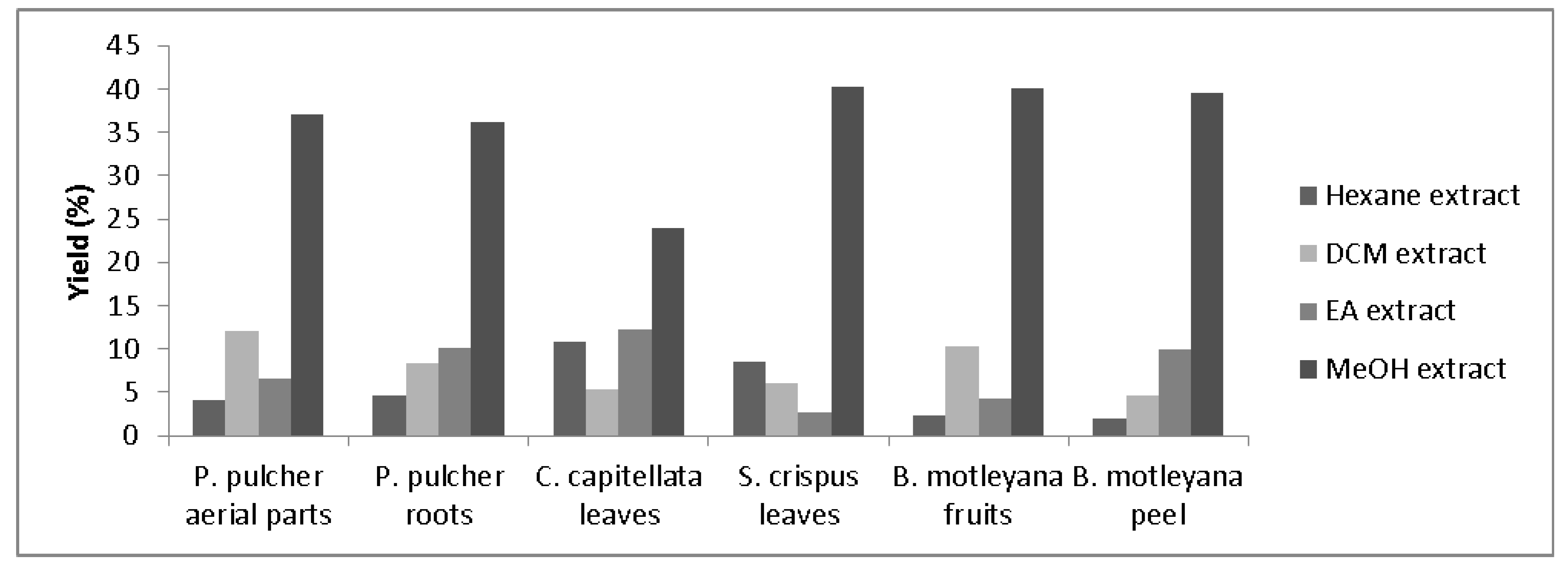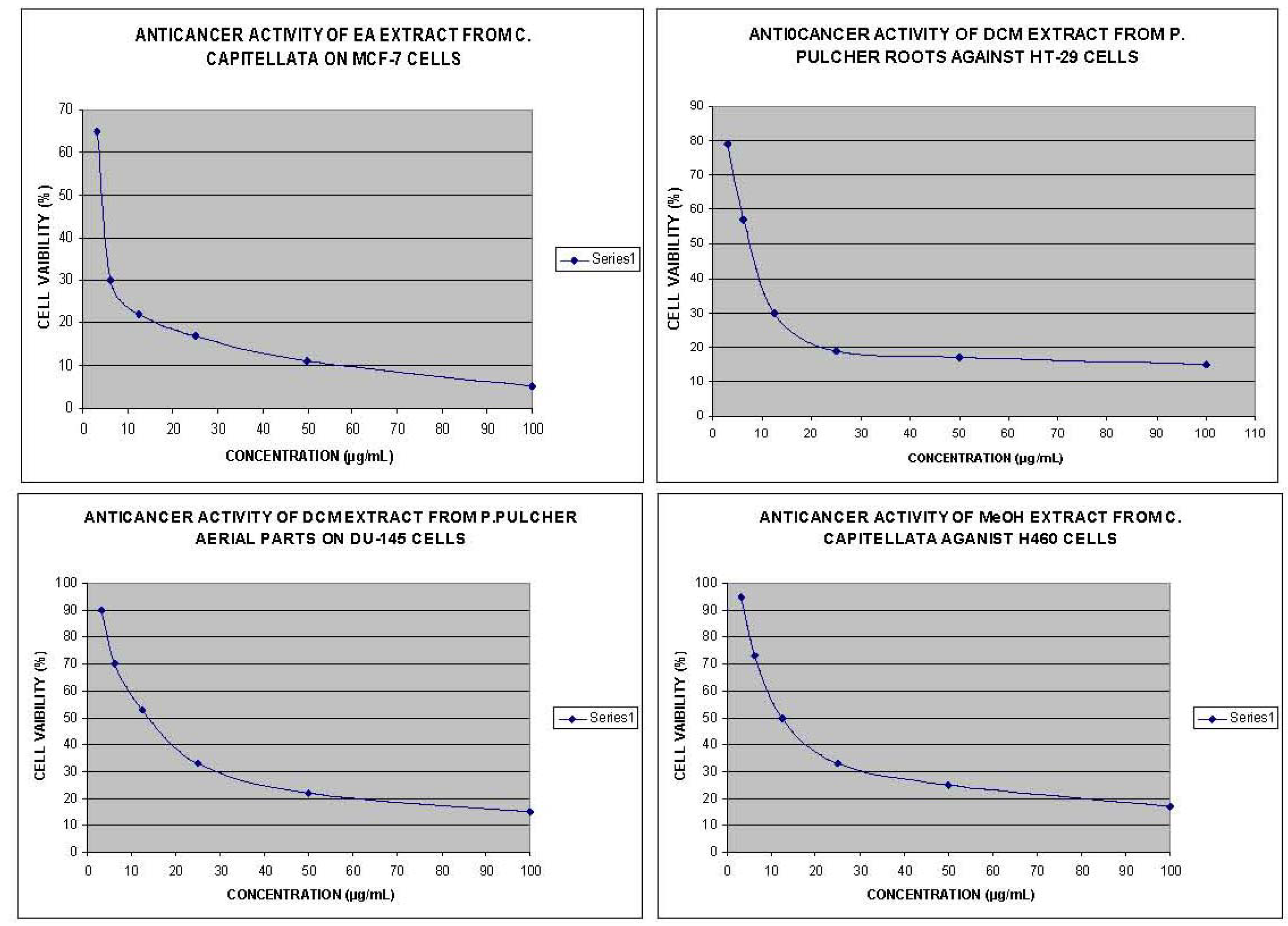Anticancer Properties and Phenolic Contents of Sequentially Prepared Extracts from Different Parts of Selected Medicinal Plants Indigenous to Malaysia
Abstract
:1. Introduction
2. Results and Discussion
2.1. Extraction and Determination of Total Phenolic Content (TPC)


| Extracts | Total phenolic content (mg gallic acid Eq/g extract) | ||||||
|---|---|---|---|---|---|---|---|
| P. pulcher Aerial parts | P. pulcher Roots | C. capitellata Leaves | S. crispus Flowers | S. crispus Leaves | B. motleyana Fruits | B. motleyana Peel | |
| Hexane | 3.4 ± 0.3 | 1.4 ± 0.6 | 1.9 ± 0.1 | 5.3 ± 0.5 | 4.9 ± 0.4 | 2.1 ± 0.1 | 3.3 ± 0.1 |
| DCM | 9.7 ± 0.3 | 3.7 ± 0.2 | 5.0 ± 0.8 | 7.3 ± 0.2 | 6.7 ± 0.1 | 4.6 ± 0.3 | 4.7 ± 0.3 |
| EA | 11.2 ± 0.3 | 9.4 ± 0.2 | 11.8 ± 0.6 | 10.4 ± 0.2 | 18.6 ± 0.9 | 6.4 ± 0.9 | 7.4 ± 0.6 |
| MeOH | 15.4 ± 0.4 | 32.0 ± 2.9 | 30.0 ± 0.3 | 17.0 ± 0.5 | 40.2 ± 0.7 | 21.0 ± 0.6 | 12.0 ± 1.9 |
2.2. Anticancer Activity
| Extracts | IC50 (μg/mL) | |||
|---|---|---|---|---|
| MCF-7 cells | DU-145 cells | H460 cells | HT-29 cells | |
| P. pulcher aerial parts | ||||
| Hexane extract | NA | NA | NA | NA |
| DCM extract | 8.0 ± 0.1 | 13.4 ± 0.4 | 50.0 ± 1.5 | 22.0 ± 0.8 |
| EA extract | NA | NA | NA | NA |
| MeOH extract | NA | NA | NA | NA |
| P. pulcher roots | ||||
| Hexane extract | NA | NA | NA | NA |
| DCM extract | 9.8 ± 1.0 | 16.7 ± 1.3 | 26.0 ± 2.0 | 8.1 ± 0.5 |
| EA extract | 18.6 ± 3.4 | 20.8 ± 2.6 | 42.0 ± 4.1 | 67.3 ± 1.4 |
| MeOH extract | NA | NA | NA | NA |
| C. capitellata leaves | ||||
| Hexane extract | NA | NA | NA | NA |
| DCM extract | 11.4 ± 2.6 | 17.0 ± 2.0 | 24.7 ± 1.3 | 42.0 ± 1.2 |
| EA extract | 2.0 ± 0.3 | 14.5 ± 0.5 | 23.4 ± 2.3 | 72.3 ± 0.6 |
| MeOH extract | 8.6 ± 0.1 | 14.4 ± 1.7 | 12.7 ± 2.1 | 25.6 ± 1.3 |
| S. crispus leaves | ||||
| Hexane extract | NT | NT | NT | NA |
| DCM extract | NT | NT | NT | NA |
| EA extract | NT | NT | NT | 70.2 ± 1.4 |
| MeOH extract | NT | NT | NT | 59.0 ± 0.8 |
| S. crispus flowers | ||||
| Hexane extract | NT | NT | NT | NA |
| DCM extract | NT | NT | NT | 90.3 ± 1.1 |
| EA extract | NT | NT | NT | 42.0 ± 1.8 |
| MeOH extract | NT | NT | NT | NA |
| B. motleyana fruits | ||||
| Hexane extract | NT | NT | NT | 51.0 ± 3.1 |
| DCM extract | NT | NT | NT | 82.4 ± 2.4 |
| EA extract | NT | NT | NT | NA |
| MeOH extract | NT | NT | NT | NA |
| B. motleyana peel | ||||
| Hexane extract | NT | NT | NT | 43.6 ± 0.3 |
| DCM extract | NT | NT | NT | 75.0 ± 1.2 |
| EA extract | NT | NT | NT | NA |
| MeOH extract | NT | NT | NT | NA |

3. Experimental
3.1. Materials
| Scientific name (family) | Common name | Plant part used | Traditional uses |
|---|---|---|---|
| Phyllanthus pulcher (Euphorbiaceae) | Naga Buana | Leaves, stems and roots | Ulcer and kidney problems |
| Casearia capitellata (Flacourtiaceae) | Simmilit matangi | Leaves | Antiseptic and anesthetic agent |
| Strobilanthes crispus (Acanthaceae) | Pecah kac or Jin batu | Leaves and flowers | Antidiabetic, diuretic and antioxidant |
| Baccaurea motleyana (Phyllanthaceae) | Rambai | Fruits and peel | For stomachache and sore eyes |
3.2. Extraction Procedure
3.3. Determination of Total Phenolic Content (TPC)
3.4. Cell Culture

3.5. Statistical Analysis
4. Conclusions
- Samples Availability: Samples of the extracts are available from corresponding author.
References and Notes
- Balunas, M.J.; Kinghorn, A.D. Drug discovery from medicinal plants. Life Sci. 2005, 78, 431–441. [Google Scholar] [CrossRef]
- Jones, W.P.; Chin, Y.W.; Kinghorn, A.D. The role of pharmacognosy in modern medicine and pharmacy. Curr. Drug Targets 2006, 7, 247–264. [Google Scholar] [CrossRef]
- Butler, M.S. The Role of Natural Product Chemistry in Drug Discovery. J. Nat. Prod. 2004, 67, 2141–2153. [Google Scholar] [CrossRef]
- Newman, D.J.; Cragg, G.M.; Snader, K.M. Natural Products as Sources of New Drugs over the Period 1981-2002. J. Nat. Prod. 2003, 66, 1022–1037. [Google Scholar] [CrossRef]
- Rosenthal, J. Curtain has fallen on hopes of legal bioprospecting. Nature 2002, 416, 15. [Google Scholar]
- Soejarto, D.D.; Gyllenhaal, C.; Fong, H.H.S.; Xuan, L.T.; Hiep, N.T.; Hung, N.V.; Bich, T.Q.; Southavong, B.; Sydara, K.; Pezzuto, J.M. The UIC ICBG (University of Illinois at Chicago International Cooperative Biodiversity Group) Memorandum of Agreement: A Model of Benefit-Sharing Arrangement in Natural Products Drug Discovery and Development. J. Nat. Prod. 2004, 67, 294–299. [Google Scholar] [CrossRef]
- Koehn, F.E.; Carter, G.T. The evolving role of natural products in drug discovery. Nat. Rev. Drug. Discov. 2005, 4, 206–220. [Google Scholar] [CrossRef]
- Parkin, D.M.; Bray, F.; Ferlay, J.; Pisani, P. Estimating the world cancer burden: Globocan 2000. Int. J. Cancer 2001, 94, 153–156. [Google Scholar] [CrossRef]
- Chen, C.C.; Liu, L.K.; Hsu, J.D.; Huang, H.P.; Yang, M.Y.; Wang, C.J. Mulberry extract inhibits the development of atherosclerosis in cholesterol-fed rabbits. Food Chem. 2005, 91, 601–607. [Google Scholar] [CrossRef]
- Prior, R.L. Fruits and vegetables in the prevention of cellular oxidative damage. Am. J. Clin. Nutr. 2003, 78, S570–S578. [Google Scholar]
- Saleem, A.; Husheem, M.; Harkonen, P.; Pihlaja, K. Inhibition of cancer cell growth by crude extract and the phenolics of Terminalia chebula retz. fruit. J. Ethnopharmacol. 2002, 81, 327–336. [Google Scholar] [CrossRef]
- McDougall, G.J.; Stewart, D. The inhibitory effects of berry polyphenols on digestive enzymes. Biofactors 2005, 23, 189–195. [Google Scholar] [CrossRef]
- Qian, J.Y.; Liu, D.; Huang, A. The efficiency of flavonoids in polar extracts of Lycium chinense Mill fruits as free radical scavenger. Food Chem. 2004, 87, 283–288. [Google Scholar] [CrossRef]
- Efuntoye, M.O.; Ayodele, A.E.; Thomas, B.T.; Ajayi, T.O. Does host plant affect the antibacterial activity of Tapinanthus bangwensis (Engl. and K. Krause) Danser (Loranthaceae)? J. Med. Plants Res. 2010, 4, 1281–1284. [Google Scholar]
- Sertié, J.A.A.; Carvalho, J.C.T.; Panizza, S. Antiulcer activity of the crude extract from the leaves of Casearia sylvestris. Pharm. Biol. 2000, 38, 112–119. [Google Scholar]
- Esteves, I.; Souza, I.R.; Rodrigues, M.; Cardoso, L.G.V.; Santos, L.S.; Sertie, J.A.A.; Perazzo, F.F.; Lima, L.M.; Schneedorf, J.M.; Bastos, J.K. Gastric antiulcer and anti-inflammatory activities of the essential oil from Casearia sylvestris Sw. J. Ethnopharmacol. 2005, 101, 191–196. [Google Scholar] [CrossRef]
- Prakasam, A.; Sethupathy, S.; Pugalendi, K.V. Antihyperglycaemic effect of Casearia esculenta root extracts in streptozotocin-induced diabetic rats. Pharmazie 2002, 57, 758–760. [Google Scholar]
- Prakasam, A.; Sethupathy, S.; Pugalendi, K.V. Hypolipidaemic effect of Casearia esculenta root extracts in streptozotocin-induced diabetic rats. Pharmazie 2003, 58, 828–832. [Google Scholar]
- Okouneva, T.; Hill, B.T.; Wilson, L.; Jordan, M.A. The Effects of Vinflunine, Vinorelbine, and Vinblastine on Centromere Dynamics1. Mol. Cancer Ther. 2003, 2, 427. [Google Scholar]
- Borges, M.H.; Soares, A.M.; Rodrigues, V.M.; Oliveira, F.; Fransheschi, A.M.; Rucavado, A.; Giglio, J.R.; Homsi-Brandeburgo, M.I. Neutralization of proteases from Bothrops snake venoms by the aqueous extract from Casearia sylvestris (Flacourtiaceae). Toxicon 2001, 39, 1863–1869. [Google Scholar] [CrossRef]
- Fadzelly, A.B.M.; Asmah, R.; Fauziah, O. Effects of Strobilanthes crispus tea aqueous extracts on glucose and lipid profile in normal and streptozotocin-induced hyperglycemic rats. Plant Food Hum. Nutr. 2006, 61, 6–11. [Google Scholar] [CrossRef]
- Ismail, M.; Manickam, E.; Danial, A.M.; Rahmat, A.; Yahaya, A. Chemical composition and antioxidant activity of Strobilanthes crispus leaf extract. J. Nutr. Biochem. 2000, 11, 536–542. [Google Scholar] [CrossRef]
- Iqbal, S.; Bhanger, M.I.; Anwar, F. Antioxidant properties and components of some commercially available varieties of rice bran in Pakistan. Food Chem. 2005, 93, 265–272. [Google Scholar] [CrossRef]
- Goli, A.H.; Barzegar, M.; Sahari, M.A. Antioxidant activity and total phenolic compounds of pistachio (Pistachia vera) hull extracts. Food Chem. 2005, 92, 521–525. [Google Scholar] [CrossRef]
- Hilton, P.J.; Palmer-Jones, R. Relationship between the flavanol composition of fresh tea shoots and the theaflavin content of manufactured tea. J. Sci. Food Agric. 1973, 24, 813–818. [Google Scholar] [CrossRef]
- Wang, S.Y.; Zheng, W. Effect of plant growth temperature on antioxidant capacity in strawberry. J. Agric. Food Chem. 2001, 49, 4977–4982. [Google Scholar] [CrossRef]
- Cragg, G.M.; Boyd, M.R.; Cardellina, J.H., II.; Newman, D.J.; Snader, K.M.; McCloud, T.G. Ethnobotany and drug discovery: The experience of the US National Cancer Institute. In Ciba Foundation Symposium 185 - Ethnobotany and the Search for New Drugs; Wiley & Sons: Chichester, UK, 2007. [Google Scholar]
- Yanez, J.; Vicente, V.; Alcaraz, M.; Castillo, J.; Benavente-Garcia, O.; Canteras, M.; Teruel, J.A.L. Cytotoxicity and antiproliferative activities of several phenolic compounds against three melanocytes cell lines: relationship between structure and activity. Nutr. Cancer 2004, 49, 191–199. [Google Scholar] [CrossRef]
- Indap, M.A.; Barkume, M.S. Efficacies of plant phenolic compounds on sodium butyrate induced anti-tumour activity. Indian J. Exp. Biol. 2003, 41, 861–864. [Google Scholar]
- Kampa, M.; Alexaki, V.I.; Notas, G.; Nifli, A.P.; Nistikaki, A.; Hatzoglou, A.; Bakogeorgou, E.; Kouimtzoglou, E.; Blekas, G.; Boskou, D. Antiproliferative and apoptotic effects of selective phenolic acids on T47D human breast cancer cells: potential mechanisms of action. Breast Cancer Res. 2004, 6, R63–R74. [Google Scholar]
- Alley, M.C.; Scudiero, D.A.; Monks, A.; Hursey, M.L.; Czerwinski, M.J.; Fine, D.L.; Abbott, B.J.; Mayo, J.G.; Shoemaker, R.H.; Boyd, M.R. Feasibility of drug screening with panels of human tumor cell lines using a microculture tetrazolium assay. Cancer Res. 1988, 48, 589. [Google Scholar]
© 2012 by the authors; licensee MDPI, Basel, Switzerland. This article is an open-access article distributed under the terms and conditions of the Creative Commons Attribution license (http://creativecommons.org/licenses/by/3.0/).
Share and Cite
Ismail, M.; Bagalkotkar, G.; Iqbal, S.; Adamu, H.A. Anticancer Properties and Phenolic Contents of Sequentially Prepared Extracts from Different Parts of Selected Medicinal Plants Indigenous to Malaysia. Molecules 2012, 17, 5745-5756. https://doi.org/10.3390/molecules17055745
Ismail M, Bagalkotkar G, Iqbal S, Adamu HA. Anticancer Properties and Phenolic Contents of Sequentially Prepared Extracts from Different Parts of Selected Medicinal Plants Indigenous to Malaysia. Molecules. 2012; 17(5):5745-5756. https://doi.org/10.3390/molecules17055745
Chicago/Turabian StyleIsmail, Maznah, Gururaj Bagalkotkar, Shahid Iqbal, and Hadiza Altine Adamu. 2012. "Anticancer Properties and Phenolic Contents of Sequentially Prepared Extracts from Different Parts of Selected Medicinal Plants Indigenous to Malaysia" Molecules 17, no. 5: 5745-5756. https://doi.org/10.3390/molecules17055745
APA StyleIsmail, M., Bagalkotkar, G., Iqbal, S., & Adamu, H. A. (2012). Anticancer Properties and Phenolic Contents of Sequentially Prepared Extracts from Different Parts of Selected Medicinal Plants Indigenous to Malaysia. Molecules, 17(5), 5745-5756. https://doi.org/10.3390/molecules17055745




